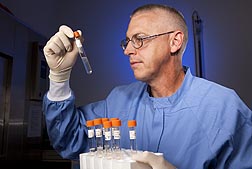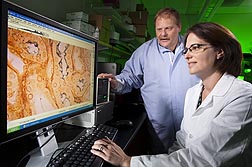Recognizing the Threat of Leptospirosis
|
|
Cattle, hamsters, and sea lions may seem like an odd combination, but they do have something in common—leptospirosis, a contagious disease found in all farm animals, rodents, and wildlife.
Leptospirosis, which is caused by Leptospira bacteria, is a widespread zoonotic disease transmitted naturally from domestic and wild animals to humans, who can become infected through contact with water, food, or soil contaminated with urine from infected animals.
“The disease in humans can often be an acute infection,” says lead scientist Richard Zuerner, a former microbiologist with the Agricultural Research Service’s National Animal Disease Center (NADC) in Ames, Iowa. “In areas where it is endemic, like Brazil, it occurs on a periodic basis, and a portion of those infected will experience pulmonary hemorrhage, which can lead to a very rapid and painful death.”
Leptospirosis in livestock can cause abortions, stillbirths, reduced milk production, and lower fertility, Zuerner says. In horses, it can also result in uveitis, a potential cause of blindness.
Less is known about leptospirosis in wildlife, such as California sea lions, but scientists are finding out how the disease is spread in these mammals, exploring vaccines for cattle that carry the virus, and using hamsters as models to better understand leptospirosis.
|
|
Sizing Up the Risk of Leptospirosis from Sea Lions
Instinct may tell people to run to the aid of helpless sea lions stranded along the West Coast, but logic will tell them to be cautious. California sea lions infected with leptospirosis pose a potential threat to public health.
Senior scientist Frances Gulland examines sick and dying seals and sea lions at the Marine Mammal Center in Sausalito, California, where she works. When a leptospirosis epidemic in sea lions occurred in 2004, Gulland and her team collected urine and kidney samples and sent them to NADC for evaluation.
There, Zuerner and David Alt, a veterinary medical officer in NADC’s Infectious Bacterial Diseases Research Unit, identified the strain—L. interrogans serovar Pomona—that causes infection in sea lions. Pomona also affects cattle and other species.
Sea lions periodically undergo acute infection outbreaks. However, research suggests that California sea lions are becoming maintenance hosts.
“Maintenance hosts normally carry the bacteria and show few outward signs of infection,” Zuerner says, “whereas accidental hosts, like humans, often come down with a severe infection.”
With the help of marine and wildlife agencies, scientists maintain a surveillance network along the Pacific coast to locate sick marine mammals. They have found that the spread of leptospirosis coincides with northern seasonal migration of males from breeding areas along the southern California coast.
“The first cases of disease outbreak were in southern California, and by the end of the year, disease-infected sea lions were found in Canada and Washington,” Zuerner says.
In 2011, sick and dying sea lions washing up from central California to the Oregon coast showed signs of kidney failure, which can be caused by leptospirosis, Gulland says. Tests revealed that some of the sea lions were infected with the disease.
How did Leptospira get into sea lion populations? This question has puzzled scientists since the disease was discovered in California sea lions in the 1970s.
“We really don’t know,” Gulland says. “We hope to find the possible source by cross-matching the strain that affects sea lions with strains from other mammals.”
A Vaccine that Induces Immunity
For cattle producers, the question may be how effective is a vaccine at reducing the shedding—excretion of bacteria by the host—and spreading of leptospirosis in their herds. To answer this question, NADC scientists continue to develop and evaluate vaccines for potency.
Several years ago, they tested a vaccine and found that it induced some protection against experimental infection with L. borgpetersenii serovar Hardjo, the primary cause of bovine leptospirosis worldwide.
Recently, Zuerner, Alt, and their colleagues at NADC—veterinary medical officers Mitchell Palmer and Steve Olsen and microbiologist Tyler Thacker—examined the commercial version of the vaccine for its ability to provide short-term and long-term protection against experimental serovar Hardjo infection.
Cattle were vaccinated twice with the commercial vaccine, a standard vaccine, or an adjuvant only (a control vaccine). One year after the second vaccination, animals were challenged withserovar Hardjo.
Another part of the study tested the commercial vaccine’s ability to induce short-term immunity to infection. Animals were immunized twice and challenged 3 months later.
The commercial vaccine appeared to be effective, Alt says. It induced greater immunologic responses than the standard vaccine and greater protection against shedding after challenge. However, it did not provide complete protection from shedding.
“One of the big differences between the 3-month versus the 1-year vaccination with the commercial vaccine is that we couldn’t detect any bacteria in either the urine or the kidney at the end of the short-term study,” Zuerner says. “Animals vaccinated and then challenged with the live bacteria were able to clear the bacterial infection of the kidney more efficiently.”
In the yearlong study, only one animal was shown to have bacteria in the kidney, he says.
The immune system of vaccinated animals exhibits a recall response and naturally elicits an appropriate reaction against the bacteria.
“The vaccine triggered immunological memory in NK cells—or natural killer cells—a group of white blood cells that, like gamma delta T cells, are a bridge between the innate and acquired immune system,” Zuerner says. “Results indicate that both NK cells and gamma delta T cells may have a role in limiting or clearing infection.”
Leptospira is a varied group of organisms containing more than 200 serovars that can cause leptospirosis, Alt says. The difficulty is that there’s almost no visible difference within the genus.
“Getting the right vaccine depends on the infecting serovar,” he says. “That’s why it’s important to continue work, despite seeing improvements with the vaccine we evaluated.”
Hamsters Are Effective Models for Leptospirosis
For some time, scientists have relied on a widely used hamster model to study the effects of leptospirosis and evaluate vaccines. But attempts to demonstrate lethal infection with Hardjo in hamsters were sporadic at best.
“The previous experiments were done before we knew serovar Hardjo occurred in two species,” Zuerner says. “So it wasn’t clear beforehand whether L. interrogans serovar Hardjoor L. borgpetersenii serovar Hardjo was being tested.”
“In the prior studies, there was no way to differentiate clearly or genetically which particular Hardjo was used to induce a lethal infection in hamsters,” Alt says.
In a recent study, NADC scientists paired two closely related L. borgpetersenii serovar Hardjo isolates. One strain produced an acute, potentially lethal infection, and the other strain produced a long-term chronic infection.
Hamsters challenged with the chronic strain at first appeared unaffected. But at the end of the study, large numbers of bacteria were observed in the kidney.
“We’re now looking at using the hamster model to understand aspects of leptospirosis and trying to identify the differences between the disease induced by the hamster-lethal strain versus the chronic strain,” Zuerner says. “The strain that develops a chronic infection more closely mimics the type of infection we see in cattle.”
These findings should prove useful for evaluating leptospirosis vaccines in small animals, Zuerner says. Small-animal studies can be conducted easily in labs and lead to vaccines that may also work for large animals.—By Sandra Avant, Agricultural Research Service Information Staff.
This research is part of Animal Health, an ARS national program (#103) described at www.nps.ars.usda.gov.
To reach scientists mentioned in this article, contact Sandra Avant, USDA-ARS Information Staff, 5601 Sunnyside Ave., Beltsville, MD 20705-5129; (301) 504-1627.
"Recognizing the Threat of Leptospirosis" was published in the January 2012 issue of Agricultural Research magazine.








